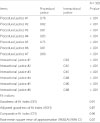1. Moorman RH. Relationship between organizational justice and organizational citizenship behaviors: do fairness perception influence employee citizenship? J Appl Psychol. 1991; 76(6):845–855. DOI:
10.1037/0021-9010.76.6.845.
2. Elovainio M, Kivimäki M, Puttonen S, et al. Organizational injustice and impaired cardiovascular regulation among female employees. Occup Environ Med. 2006; 63:141–144. DOI:
10.1136/oem.2005.019737. PMID:
16421394.
3. Cohen-Charash Y, Spector PE. The role of justice in organizations: a meta-analysis. Organ Behav Hum Decis Process. 2001; 86(2):278–321. DOI:
10.1006/obhd.2001.2958.

4. Fassina NE, Jones DA, Uggerslev KL. Meta-analytic tests of relationships between organizational justice and citizenship behavior: testing agent-system and shared-variance models. J Organ Behav. 2008; 29:805–828. DOI:
10.1002/job.494.

5. Shaw JC, Wild E, Colquitt JA. To justify or excuse? A meta-analytic review of the effects of explanation. J Appl Psychol. 2003; 88(3):444–458. DOI:
10.1037/0021-9010.88.3.444. PMID:
12814294.
6. Fujishiro K, Heaney CA. Justice at work, job stress, and employee health. Health Educ Behav. 2007; 36(3):478–504.

7. Ndjaboue R, Brisson C, Vezina M. Organisational justice and mental health: a systematic review of prospective studies. Occup Environ Med. 2012; 69(10):694–700. DOI:
10.1136/oemed-2011-100595. PMID:
22693265.
8. Moliner C, Cropanzano R, Martínez-Tur V. Organizational Justice: International Perspectives and Conceptual Advances. Routledge; 2017.
9. Cropanzano R, Byrne ZS, Bobocel DR, et al. Moral virtues, fairness heuristics, social entities, and other denizens of organizational justice. J Vocat Behav. 2001; 58(2):164–209. DOI:
10.1006/jvbe.2001.1791.

10. Inoue A, Kawakami N, Tsutsumi A, et al. Reliability and validity of the Japanese version of the organizational justice questionnaire. J Occup Health. 2009; 51(1):74–83. DOI:
10.1539/joh.L8042. PMID:
19096197.

11. Elovainio M, van den Bos K, Linna A, et al. Combined effects of uncertainty and organizational justice on employee health: testing the uncertainty management model of fairness judgments among Finnish public sector employees. Soc Sci Med. 2005; 61:2501–2512. DOI:
10.1016/j.socscimed.2005.04.046. PMID:
15990210.

12. van den Bos K, Lind EA. Uncertainty management by means of fairness judgments. In: Zanna MP, editor. Advances in experiments social psychology. San Diego: Academic Press; 2002. P.1–60.
13. Rineer JR, Truxillo DM, Bodner TE, et al. The moderating effect of perceived organizational support on the relationships between organizational justice and objective measures of cardiovascular health. Eur J Work Organ Psy. 2017; 26(3):339–410.

14. Hayashi T, Odagiri Y, Takamiya T, et al. Organizational justice and insomnia: a prospective cohort study examining insomnia onset and persistence. Int Arch Occup Environ Health. 2017; 90(1):133–140. DOI:
10.1007/s00420-016-1183-x. PMID:
27812753.

15. Ferrie JE, Head J, Shipley MJ, et al. Injustice at work and incidence of psychiatric morbidity: the Whitehall II study. OccupEnviron Med. 2006; 63:443–450.

16. Kivimäki M, Elovainio M, Vahtera J, et al. Association between organizational inequity and incidence of psychiatric disorders infemale employees. Psychol Med. 2003; 33:319–326. DOI:
10.1017/S0033291702006591. PMID:
12622310.
17. Ylipaavalniemi J, Kivimäki M, Elovainio M, et al. Psychosocial work characteristics and income of newly diagnosed depression: a prospective cohort study of three different models. Soc Sci Med. 2005; 61:111–122. DOI:
10.1016/j.socscimed.2004.11.038. PMID:
15847966.
18. Nakane C. Japanese Society. 1970. Berkeley: University of California Press.
19. Hofstede G. Cultures and Organizations. 1991. New York: McGraw-Hill;p. 139–158.
20. Skarlicki DP. Cross-cultural perspectives of organizational justice. Int J Confl Manag. 2001; 12(4):292–294. DOI:
10.1108/eb022859.

21. Elovainio M, Kivimäki M, Vahtera J. Organizational justice: evidence of a new psychosocial predictor of health. Am J Public Health. 2002; 92(1):105–108. DOI:
10.2105/AJPH.92.1.105. PMID:
11772771.

22. Kivimäki M, Elovainio M, Vahtera J, et al. Organizational justice and health of employees: prospective cohort study. Occup Environ Med. 2003; 60:27–34. DOI:
10.1136/oem.60.1.27. PMID:
12499453.
23. Banville D. Translating Questionnaires and Inventories using a cross-cultural translation technique. J Hum Kinet. 2000; 19(3):374–387.

24. Chang SJ, Koh SB, Kang DM, et al. Developing an occupational stress scale for Korean employees. Kor J Occup Environ Med. 2005; 17(4):297–317.
25. Karasek R. Job content questionnaire and user's guide. 1985. Lowell: University of Massachusetts at Lowell.
26. Siegrist J, Starke D, Chandola T, et al. The measurement of effort-reward imbalance at work: European comparisons. Soc Sci Med. 2004; 58:1483–1499. DOI:
10.1016/S0277-9536(03)00351-4. PMID:
14759692.

27. Belkic K, Savic C. The occupational stress index-an approach derived from cognitive ergonomics applicable to clinical practice. Scand J Work Environ Health. 2008; 6:169–176.
28. Hurrell JJ, McLaney MA. Exposure to job stress—a new psychometric instrument. Scand J Work Environ Health. 1988; 14(1):27–28. DOI:
10.5271/sjweh.1954. PMID:
3393871.
29. Hu L, Bentler PM. Cutoff criteria for fit indexes in covariance structural analysis: conventional criteria versus new alternatives. Struct Equ Model. 1999; 6(1):1–55. DOI:
10.1080/10705519909540118.
30. Herr RM, Li J, Bosch JA, et al. Psychometric properties of a German organizational justice questionnaire (G-OJQ) and its association with self-rated health: findings from the Mannheim industrial cohort studies (MICS). Int Arch Occup Environ Health. 2014; 87:85–93. DOI:
10.1007/s00420-012-0839-4. PMID:
23266905.

31. Abramson PR, Inglehart R. Value change in global perspective. 1995. Ann Arbor: University of Michigan Press.
32. Alston JP. Wa, Guanxi, and Inwha: managerial principles in Japan, China, and Korea. Bus Horiz. 1989; 32(2):26–30. DOI:
10.1016/S0007-6813(89)80007-2.
33. Paik Y, Tung RL. Negotiating with East Asia: how to attain “win-win” outcomes. MIR. 1999; 39(2):103–122.
34. Hofstede GH. Culture's consequences: international differences in work-related values. 1980. Beverly Hills: Sage.
35. Elovainio M, Kivimäki M, Helkama K. Organizational justice evaluations, job control and occupational strain. J Appl Psychol. 2001; 86(3):418–424. DOI:
10.1037/0021-9010.86.3.418. PMID:
11419802.

36. Lind EA, Kray L, Thompson L. The social construction of injustice: fairness judgments in response to own and Others' unfair treatment by authorities. Organ Behav Hum Decis Process. 1998; 75(1):1–22. DOI:
10.1006/obhd.1998.2785. PMID:
9719655.

37. Colquitt JA. On the dimensionality of organizational justice: a construct validation of a measure. J Appl Psychol. 2001; 86(3):386–400. DOI:
10.1037/0021-9010.86.3.386. PMID:
11419799.

38. Kim TY, Leung K. Forming and Reacting to overall fairness: a cross-cultural comparison. Organ Behav Hum Decis Process. 2007; 104(1):83–95. DOI:
10.1016/j.obhdp.2007.01.004.

39. Whitman DS, Caleo S, Carpenter NC, et al. Fairness at the collective level: a meta-analytic examination of the consequences and boundary conditions of organizational justice climate. J Appl Psychol. 2012; 97(4):776–791. DOI:
10.1037/a0028021. PMID:
22486364.










 PDF
PDF Citation
Citation Print
Print



 XML Download
XML Download